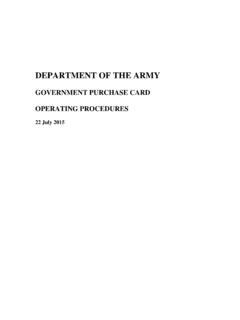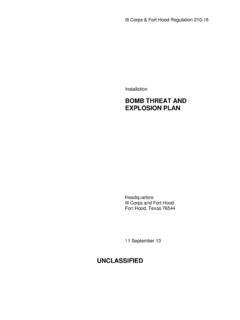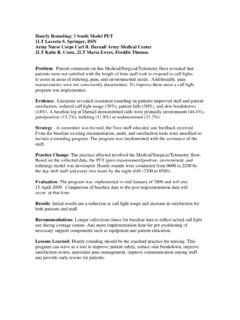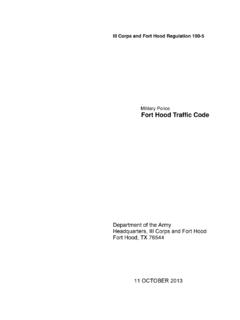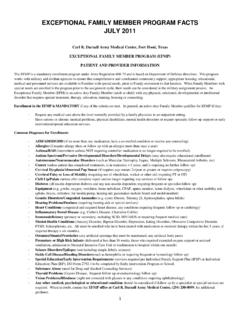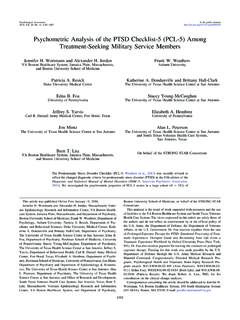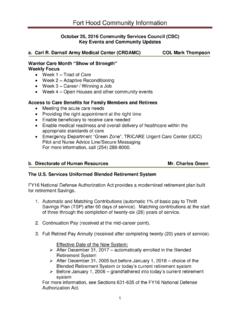Transcription of HEADQUARTERS, US ARMY MEDICAL COMMAND
1 UNCLASSIFIED//FOR OFFICIAL USE ONLY 1 UNCLASSIFIED//FOR OFFICIAL USE ONLY headquarters , US army MEDICAL COMMAND Falls Church, VA 22042-5140 191400Q September 2017 OPERATION ORDER 17-91 (ACQUISITION PLANNING GUIDANCE) USAMEDCOM References: a. FAR Agency Head Responsibilities, 13 Jan 17. b. FAR Agency Head Responsibilities, 13 Jan 17. c. DFARS Contents of written Acquisition Plan, 7 Jun 16. d. FAR Earned Value Mgt. Policy, 18 Nov 16. e. ASAALT, Memorandum Annual Requirement for the Development of a COMMAND 1-N Contract Prioritization List, 20 Nov 13. Time Zone Used Throughout the Order: Quebec (Eastern Daylight Time). Task Organization: No Change. 1. Situation. a. Acquisition planning is critical to the successful delivery of health care to our beneficiaries. Good acquisition planning is continuous and assists in creating a shared common operating picture among all stakeholders and serves as a conduit to increase the communications between the contracting activities and the Requiring Activity (RA).
2 Good communications will minimize delays in the contracting process and decrease the incidence of unexpected requirements. b. The Vice Chief of Staff of the army (VCSA) and the Deputy Assistant Secretary of the army for Procurement (DASA-P) have directed all commands develop and maintain a prioritized all-inclusive list of contracts (1-N List) each year. The Contracting 1-N List is the management control that determines the contracting workload for each RA for the fiscal year and serves as the primary document by which the Contracting Activities and Requiring Activities manage their contracting needs. c. The US army MEDICAL COMMAND (MEDCOM) is currently facing a significant contingent liability for its lack of acquisition discipline. For the past 5 years, poor planning and contract administration has resulted in millions of dollars left on contracts that should have been de-obligated. This has resulted in a contingent liability on current UNCLASSIFIED//FOR OFFICIAL USE ONLY OPERATION ORDER 17-91 (ACQUISITION PLANNING GUIDANCE) USAMEDCOM 2 UNCLASSIFIED//FOR OFFICIAL USE ONLY year funding.
3 In order to prevent future years contingent liability, we must employ good contract administration practices including timely de-obligations and better cost estimates for our contracting requirements, especially when exercising options on contracts that are historically under-executed. d. The MEDCOM has identified a need to improve Contract Administration via Contracting Officer Representatives (CORs) continuous monitoring of fill rates and burn rates on all personal and non-personal service and supply contracts. During the Unauthorized Commitment (UC) Root Cause Analysis briefs, MEDCOM identified that a number of UCs were directly linked to the failure of contract administration. An example of effective Program Management of contract administration is the centralized COR Model at carl R Darnall army MEDICAL Center (CRDAMC). CRDAMC has created fulltime DHCP COR positions and centralized them under a fulltime COR Supervisor. By creating a centralized COR Cell, CRDAMC has enabled Department Administrators to focus on their clinical responsibilities rather than managing contracts.
4 The effectiveness of the COR Cell is measurable. As a result of the effective monitoring of the execution and burn rates, the CRDAMC DHCP CORs have not had a UC in over 6 years. CRDAMC s COR Cell initiates quarterly de-obligations, which allows funds to be reprogrammed. Additionally, they are able to provide better customer support including: educating the customer on the dos and don'ts about working with contract personnel; conducting monthly surveillance with their department POCs regarding the contractor's performance; completing all monthly COR reports in the COR Tool on time. All invoices are paid before interest accrues. They in-process and out-process all contract personnel. Their increased ability to interact with the customers results in complete Requirements Packets received by Contracting in accordance with the established cut-off dates. e. All organizations that rely on US army Health Contracting Activity (USAHCA)/US army MEDICAL Research Acquisition Activity (USAMRAA) for contracting and assistance agreement support are referred to as Requiring Activity(ies) throughout this document.
5 F. All contracting and assistance agreement needs from the Requiring Activities are also referred to as Requirement(s) throughout this document. 2. Mission. MEDCOM performs continuous Acquisition Planning effective immediately until 1 Sept 19 in order to proactively manage the contracting/assistance agreement needs of army Medicine. 3. Execution. a. Commander s Intent. Complying with the established cutoff dates contained herein is mandatory for all Requiring Activities support by USAHCA and USAMRAA. Early and frequent communication is critical. It is important that each Requiring Activity and Contracting Activity work together to identify contracting needs as soon as they UNCLASSIFIED//FOR OFFICIAL USE ONLY OPERATION ORDER 17-91 (ACQUISITION PLANNING GUIDANCE) USAMEDCOM 3 UNCLASSIFIED//FOR OFFICIAL USE ONLY materialize. All parties should identify Requirements that are candidates for consolidation either at the Regional Health COMMAND (RHC), USAMRMC or MEDCOM level.
6 Deliberate action should be taken to submit complete Requirements Packets for recurring (Option year), re-compete and expiring requirements before the specified cutoff date. The Requiring Activities and Contracting Activities use the Contracting 1-N List to establish timelines for submission of known current and following year requirements: (1) Prepare and Submit 1-N List. (2) Use Contracting 1-N List to establish Acquisition Plan. (3) Submit complete Requirements Packets. (4) Identification and processing of current year deobligations. (5) Identification and process of canceling year deobligations. b. End State. The MEDCOM creates a collaborative and proactive procurement environment to support army Medicine. c. Concept of Operations. Requiring Activities and Contracting Activities shall use the Contracting 1-N List to establish timelines for the submission of Requirements packets so that all packets are received no later than the prescribed cutoff contained in Annex R (USAHCA Cutoff Dates) and Annex W (USAMRAA cutoff dates).
7 Active Contract Administration by the CORs/Grant Officer representative (GORs) includes active monitoring of fill rates, burn rates and submission of data supported cost estimates. The USAHCA/USAMRAA will ensure synchronization with all Requiring Activities to assist with meeting cutoff dates for submission of remaining FY18 Requirements and all FY19 Requirements according to the jointly established Acquisition Plan. d. Tasks to Subordinate Units. Regional Health Commands (RHCs), and Major Subordinate Commands (MSCs). (1) The COMMAND Prioritization of Contract Requirements (Contracting 1-N List) is submitted to MEDCOM Program Analysis and Evaluation (PA&E) via tasker To Be Published (TBP). (2) All MSCs/RHCs will coordinate with supporting Contracting Activity in order to validate the recurring (Option year), re-compete and expiring requirements on the Contracting 1-N List NLT 1 Nov 17. UNCLASSIFIED//FOR OFFICIAL USE ONLY OPERATION ORDER 17-91 (ACQUISITION PLANNING GUIDANCE) USAMEDCOM 4 UNCLASSIFIED//FOR OFFICIAL USE ONLY (3) All RHC Chief of Staffs will brief the MEDCOM CoS and DCS-Procurement their plan to execute all FY18 MEDICAL requirements NLT 21 Nov 17.
8 (4) For RHCs: The Summer Gap Period of Performance (PoP) is considered 1 May 18 to 30 Sep 18. (a) Submit forecast for FY18 Summer Gap contracting requirements NLT 15 Oct 17. (b) Submit all completed FY18 Summer Contracting Requirements Packets to the supporting Contracting Activity NLT 1 Nov 17. (5) At least annually, conduct or evaluate periodic spend analyses for service and supply acquisitions under their authority. (a) Contract Execution Review Board (CERB). All requiring activities will establish a CERB to review all contracts starting with those in the 3rd year of execution (Option Year 2) and all subsequent Options years NLT 30 Mar 18. CERB will consist of representative from the supporting contracting office, Requiring Activity, Resource Management (RM), and Contracting Officer Representative (COR). THIS IS AN ANNUALLY RECURRING REQUIREMENT. (b) The CERB will review all contracts in Option Year 2 and beyond.
9 If the contract execution is under 80% in the base and 1st option year, consideration will be given to decreasing the contracting requirement in the following FY to more closely match actual execution. By bringing the contract in line with the historical execution, we achieve three objectives: 1. Maximize buying power for the activity. 2. Minimize need to deobligate. 3. Free up requirements and dollars to be placed against a different vehicle that may result in better Fill Rates/Execution. (6) Contract Administration is performed by the CORs/GORs at each Requiring Activity and is essential to timely identification of deobligation requirements and aids in the avoidance of Unauthorized Commitments through the continuous monitoring of fill rates and burn rates. In order to complete proper contract reconciliation, all CORs must maintain General Fund Enterprise Business System (GFEBS) access to validate execution.
10 (a) All CORs/GORs will have MEDCOM approved COR/GOR smart objective(s) in their performance evaluation. UNCLASSIFIED//FOR OFFICIAL USE ONLY OPERATION ORDER 17-91 (ACQUISITION PLANNING GUIDANCE) USAMEDCOM 5 UNCLASSIFIED//FOR OFFICIAL USE ONLY (b) Consideration should be given to the establishment of a centralized Contract Administration capability. (c) All CORs/GORs will attend the COR/Acceptor Training at least once every 24 months. Tentative scheduled locations and dates as follows: 1. RHC Atlantic: Fort Gordon, GA TBD. 2. RHC Central: Fort Bliss, TX 22 Jan 2018, Fort Carson, CO 20 Feb 18, and JBSA Fort Sam Houston, TX 5 Mar 18. 3. RHC Pacific: Tripler army MEDICAL Center (TAMC), HI 12 Dec 17. 4. RHC Europe: Landstuhl, GE 14 May 18. 5. USAMRMC: Fort Detrick, MD 16 Apr 18. (d) The CORs will complete the Quality and Narrative Writing ( hours).
